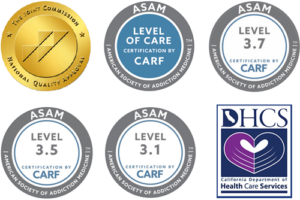Is Alcohol a Stimulant?
Published on: February 14, 2022 | Updated on: December 5, 2025
Is Alcohol a Stimulant or a Depressant?
When we think about how alcohol makes us feel, we might first think about its relaxation effects. However, alcohol is not only desired for its depressant effects on the central nervous system; it also has stimulating effects . In fact, alcohol can be both a stimulant and a depressant.
Is Alcohol Ever Used as a Stimulant?
Contrary to the belief that alcohol is solely a depressant, alcohol also can produce stimulant effects. These include the initial stimulant effects of alcohol :
- Increased breathing rate
- Increased heart rate
- Increased energy
- Increased confidence, sometimes leading to risky behaviors
- Increased aggression, including fighting
Each person is affected by alcohol in a unique way because body chemistry differs so much. Some people may feel the stimulant properties more so than others. In most people, the stimulant effects are short-lived, which give way to the sedating effects with continued drinking. For those who partake in excessive alcohol consumption, both stimulant effects and depressant effects of alcohol can be magnified, sometimes leading to substance use disorders or alcohol misuse.
One study reveals that there is a higher risk for alcoholism if the person has a reduced sedative response when they drink. This suggests that the risk is higher for those who have a more pronounced stimulatory response to alcohol. The authors posit that this is due to the fact that stimulant effects are more rewarding than relaxing effects, which can impact brain function .
Alcohol’s Impact on the Body
Alcohol can have various physical effects on the human body, ranging from immediate to long-term health consequences. Here’s a breakdown of these effects, including alcohol’s depressant effects :
-
Digestive System: Alcohol can cause irritation in the gastrointestinal tract, which can lead to gastritis and ulcers. It also impairs nutrient absorption by damaging the cells lining the stomach and intestines.
- Liver: Heavy drinking is a major cause of liver disease, including fatty liver, alcoholic hepatitis, fibrosis, and cirrhosis. The liver is responsible for detoxifying alcohol, and excessive alcohol can overwhelm this process, leading to liver damage.
- Pancreas: Alcohol causes the pancreas to produce toxic substances that can eventually lead to pancreatitis, a dangerous inflammation and swelling of the blood vessels in the pancreas that inhibits proper digestion.
- Cardiovascular System: Alcohol can affect the heart and blood vessels in various ways. While moderate alcohol consumption might have some protective benefits against coronary heart disease, excessive drinking can lead to high blood pressure, cardiomyopathy (a disorder of the heart muscle), arrhythmias (irregular heartbeat), and stroke.
- Immune System: Alcohol use can weaken the immune system, making the body more susceptible to diseases. Chronic drinkers are more likely to contract diseases like pneumonia and tuberculosis than people who do not drink too much.
- Musculoskeletal System: Alcohol interferes with the production of new bone, leading to thinning bones and an increased risk of fractures. It also causes muscle weakness and cramping.
- Endocrine System: Alcohol influences the endocrine system and can disrupt the hormonal balance, affecting many body functions including reproductive health. In men, it can lead to erectile dysfunction and a decrease in testosterone levels, while in women, it may cause disruptions in the menstrual cycle.
- Kidneys: Alcohol affects the kidneys’ ability to regulate the balance of fluids and electrolytes in the body, and it can also increase the risk of kidney disease. In some cases, alcohol slows metabolic processes, interfering with physical health. More alcohol consumption only makes these symptoms worse.
- Skin: Alcohol dehydrates the body, including the skin, which can lead to premature aging and dryness. It can also cause flushing and redness of the skin, particularly on the face and chest.
- Weight and Metabolism: Alcohol is high in calories and can contribute to weight gain. It also interferes with the body’s ability to burn fat and significantly affects the metabolism of carbohydrates, proteins, and lipids.
These effects can vary widely depending on factors like the amount of alcohol consumed, frequency of drinking, genetic makeup, overall health, and other individual differences. Chronic, heavy alcohol use, which is a form of excessive alcohol use, is particularly damaging and can lead to severe health issues, including an increased risk of various cancers like liver, mouth, throat, larynx, and esophagus.
Alcohol Consumption: Effects of Alcohol on the Central Nervous System
Alcohol has a significant impact on the central nervous system (CNS), manifesting in both acute and long-term effects that can range from mild impairment to severe neurological damage. It is here that the depressant effects of alcohol drinking lead to certain risk factors that can alter long-term mental health.
Here’s how alcohol affects the CNS:
- Immediate Effects:
- Reduced Inhibitions: Alcohol acts as a depressant, initially decreasing the function of the frontal lobes of the brain, which are responsible for judgment, behavior, and inhibition.
- Impaired Coordination and Motor Skills: Alcohol disrupts the cerebellum, the part of the brain that controls motor coordination, leading to clumsiness, unsteady gait, and difficulty performing complex movements.
- Slurred Speech: The impairment of brain centers that govern speech results in slurred speech, a common symptom of intoxication.
- Altered Mood and Behavior: Alcohol can cause mood swings and drastic changes in behavior, ranging from becoming overly emotional to aggressive.
- Sensory Alteration: Alcohol can dull the senses, leading to blurred vision, altered sense of smell and taste, and reduced sensitivity to pain.
- Long-Term Effects:
- Neurological Damage: Chronic alcohol use can lead to permanent damage to the brain structure and function. This damage manifests as memory loss, impaired executive function, reduced cognitive flexibility, and difficulty with problem-solving.
- Wernicke-Korsakoff Syndrome: This serious condition is caused by a deficiency in thiamine (vitamin B1) and is often seen in people who abuse alcohol. It features two phases: Wernicke’s encephalopathy, which presents as confusion, loss of muscle coordination, and abnormal eye movements; and Korsakoff’s psychosis, characterized by severe memory issues.
- Dependency and Withdrawal: Repeated alcohol use can lead to dependence, characterized by a need to drink to function or feel normal. Withdrawal from alcohol can affect the CNS, leading to symptoms such as tremors, agitation, hallucinations, and seizures.
- Sleep Disturbances: Alcohol can significantly impact sleep patterns, contributing to insomnia and interrupting the sleep cycle, particularly by disrupting REM sleep.
What is Binge Drinking?
Binge drinking is a pattern of drinking alcohol that brings blood alcohol concentration (BAC) to 0.08 percent—or 0.08 grams of alcohol per deciliter—or higher. For a typical adult, this pattern corresponds to consuming 5 or more drinks (male), or 4 or more drinks (female), in about 2 hours. The definition can vary slightly by country, but the focus is consistently on consuming a large amount of alcohol in a short period.
Characteristics and Risks of Binge Drinking:
- Prevalence: It is a common practice among all age groups but is particularly prevalent in young adults and college students.
- Health Risks: Binge drinking is associated with a wide range of health and societal issues. These include acute consequences like injuries (accidents, falls, fights), alcohol poisoning, risky sexual behavior, and violence. Chronic binge drinking can lead to long-term health problems such as liver disease, cardiovascular diseases, sleep disorders, and neurological damage.
- Psychological and Social Issues: It can exacerbate or lead to mental health problems such as depression and anxiety, and can significantly impact social relationships and professional commitments. With severe impacts to the central nervous system, including depressant effects and increased alcohol tolerance, if a person chooses to binge drink alcohol, they are putting their lives and mental health at risk.
- Alcohol Dependence: Regular binge drinking can increase the risk of developing alcohol use disorders. Some individuals with severe dependence may even drink rubbing alcohol, which is extremely dangerous because it contains isopropyl alcohol—a toxic substance that can cause gastrointestinal bleeding, organ failure, and life-threatening poisoning.
Efforts to mitigate the impacts of binge drinking include educational programs, policy-making that addresses alcohol availability and pricing, and interventions designed to increase awareness about the dangers of excessive alcohol consumption.
Signs of Alcohol Abuse and Addiction
Whichever effects are driving the alcohol abuse, the end result can be devastating. With continued heavy drinking, the body builds up tolerance and requires even more of the substance. As this cycle carries on, an alcohol addiction and alcohol use disorder (AUD) often results.
So, what is an AUD and how do you know if you have one? Consider these criteria for AUD, as suggested by medical professionals :
- Unable to limit drinking.
- Place drinking above all else. The world revolves around alcohol.
- Have memory blackouts.
- Have alcohol cravings.
- Hides alcohol or lies about how much they drink.
- Shirk family and work obligations; missing work due to hangovers.
- Keeps drinking despite the mounting consequences.
- Loss of impulse control; engage in high-risk behaviors, such as driving under the influence, unsafe sex, getting into fights.
- Sustains injuries due to drinking.
- Stops taking care of appearance or hygiene.
- Withdraws from social settings or events; give up hobbies.
- Increased tolerance to effects of alcohol leading to higher consumption.
- Attempts to reduce or stop drinking but cannot.
- Withdrawal symptoms emerge when the effects of alcohol wear off.
When the brain imprints the positive effects of drinking as something to be repeated, it begins to etch new pathways in the central nervous system. The cravings for alcohol grow stronger and drinking becomes a compulsive action that can no longer be controlled. This is called alcohol addiction.
Consequences of Alcohol Abuse
What may start off as innocent partying or a daily beer after work can grow into an AUD in certain people. It is still not fully known why some people are able to abuse alcohol and never acquire an AUD, where others will.
Alcohol abuse can have a highly damaging effect on someone’s life. Some of the consequences of alcohol abuse, especially as it evolves into an AUD, include:
- Damage to relationships. Alcohol abuse can cause serious problems in someone’s primary relationships. The collateral damage of a drinking problem reaches into these relationships causing pain, disappointment, frustration, and fear. Divorce is often caused by someone’s alcohol abuse.
- Damage to career. When drinking takes the top spot in someone’s life, their career will begin to suffer. Not only does he or she become less productive, but they may miss work often due to having hangovers. They miss meetings, don’t complete projects on time, and let their colleagues down.
- Legal problems. Alcohol abuse is widely known to lead to legal issues. These may involve a DUI arrest(s). Legal issues may also involve domestic abuse or assault charges from a bar fight.
- Health problems. Alcohol is highly damaging to health, and can cause many health problems if drinking continues. People with AUD are at higher risk for many types of cancer, heart disease, liver disease, and brain damage.
- Parenting issues. When a spouse can no longer fulfill their parenting roles they may find themselves in a court battle. This occurs when the alcoholic spouse neglects his or her duties as a parent or could cause the child harm.
- Money problems. Job loss, mounting legal fees, and the cost of alcohol all add up. This can lead to serious money problems. When money problems become a heavy burden, drinking escalates, so it becomes a vicious cycle.
- Mental health problems. Anxiety and depression, including increased suicide risk, are common in people with severe AUD. The growing negative effects of the AUD can overwhelm the person and cause mental health problems. In many cases, though, the mental health issue was present before the AUD. Drinking helped to numb the symptoms caused by the mental health disorder, and then led to addiction.
A Word About Alcohol Poisoning
Alcohol poisoning is a serious and potentially deadly condition resulting from consuming a large amount of alcohol in a short period. Severe danger exists for those who mix alcohol consumption and another depressant substance like depressant drugs or medications.
This excessive intake of alcoholic beverages overwhelms the body’s ability to metabolize alcohol, leading to a rapid increase in blood alcohol concentration that can suppress vital functions. Symptoms of alcohol poisoning include confusion, vomiting, seizures, slow or irregular breathing and heart rate, blue-tinged or pale skin, hypothermia, and unconsciousness.
It is a medical emergency that requires immediate attention to prevent fatal outcomes. Prompt medical treatment often involves supportive care, such as managing breathing, hydration, and preventing further alcohol absorption. Alcohol poisoning underscores the critical dangers of binge drinking and highlights the need for awareness and moderation in alcohol consumption.
Addiction Treatment Options for Alcohol Use Disorder
- Detox. The detox process is the first step in recovery. During detox, a trained detox team will care for you. The team will manage the withdrawal symptoms and minimize pain and discomfort. Detox takes about 5-7 days to complete.
- Talk therapy. CBT and DBT are two approaches that are widely used in addiction treatment.
- Group therapy. A licensed clinician leads group sessions and provides recovery-related topics for the peers to discuss.
- Family therapy. Family-centered group sessions provide a safe space for family members to discuss family issues. Family members also learn how they can support their loved ones in recovery.
- 12-step program. The 12-step program can provide structure and guidance in early recovery and beyond.
- Education. The psycho-social aspect of treatment equips the person with new coping tools and recovery skills. Classes also teach about the science of addiction and how to prevent a relapse.
- Holistic. These include art therapy, yoga, mindfulness, massage, nutritional counseling, and outdoor exercise.
So, is alcohol a stimulant? Is it a depressant? What we have learned is that alcohol effects include both features. Either way, if an AUD has developed, it is time to seek help.
Journey Hillside Provides Evidence-Based Treatment for Alcohol Use Disorder
Journey Hillside Tarzana offers the most up to date, evidence-based treatment approaches for helping clients overcome alcohol use disorder and improve their well being . If you or a loved one are struggling with alcohol abuse or an AUD, Journey Hillside is here to help. Please reach out to us today at (877) 414-1024.





